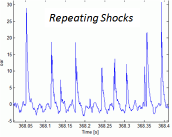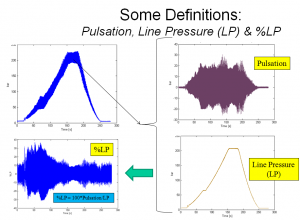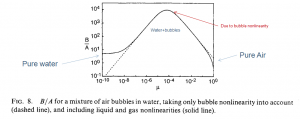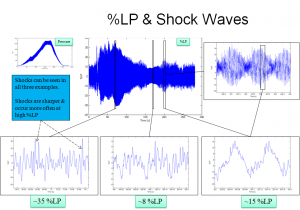Shock Waves from Non-linear Wave Steepening
Wave steepening is a non-linear wave propagation effect that arises for strong pulsation in bubbly liquids, e.g. as is the case for reciprocating pumps and water or oil based mud. Steepening form repetetive shocks and may adversely affect pump equipment and piping fatigue life.
To understand this shock generating mechanism, we must first better understand what is implied by the phrase Pressure.
There are three pressure components:
- Line Pressure (LP)
- Kinetic Pressure (KP)
- Pulsation
Line Pressure is the stationary part of the pressure, Kinetic Pressure is pressure that moves with the flow (i.e. with the motion of matter) and Pulsation is pressure that propagates with a flow velocity of zero net transportation of matter.
These three pressure components are different animals. For example:
- LP is stationary; it neither moves nor oscillates, though it may increase or decrease depending on the average matter density.
- Kinetic Pressure (KP) is associated with flow of matter and is defined as 0.5*ρ*U2, where flow speed is U and density is ρ. KP is a vector in the same way that flow is a vector, i.e. it differs with direction and from one position to another. Kinetic Pressure can be very high locally but be very low a short distance away.
- Pulsation is oscillating pressure that can oscillate matter back and forth, but has zero net propagation of matter. Pulsation propagates as waves and is more or less everywhere in the system once it is generated.
Wave propagation is linear when the ratio of Pulsation to LP is small and non-linear when the ratio is high. This number is commonly referred to as %LP = 100*Pulsation/LP. Here is an example where the pressure sensor is placed so that it is insensitive to Kinetic Pressure and, thus, is only subject to LP and Pulsation (see Figure 1).
Figure 1. The top left subfigure shows pressure. The top right subfigure shows pulsation as derived using a high pass filter for the pressure signal. The bottom right subfigure shows Line Pressure (LP) as derived using a low pass filter with an identical cut off frequency as was used for the Pulsation signal. The bottom left subfigure shows %LP and indicates whether we should expect linear (low %LP values, say 1% or less) or non-linear wave propagation. Wave steepening is a non-linear effect. (Click figure to expand)
When %LP is high, the wave trough (low point) travels at a lower propagation speed than the wave crest (high point). It follows that after a certain propagation distance, XS, the wave crest will catch up with the wave. At this time, the waveform becomes steep and a shock wave is formed. Once formed, the shock wave propagates at high speed until it either impacts on a wall or collapses from disturbances along its path.
Here is the shock formation mechanism outlined (see Figure 2):
Figure 2. High wave amplitude wave propagation causes the wave crest to propagate faster than the wave trough. The wave crest catches up with the wave trough after some distance, XS, the so called shock formation distance.The shock wave then breaks down and the shock formation process is restarted. Shock waves are also called freak waves. The process shown in this figure is analogous to the freak and monster waves that are found at sea. (Click figure to expand)
The distance XS required to form a repetitive shock wave is:
XS = λ ∙ γ /[1+B/(2A)] ∙ 100/(%LP),
where the specific heat ratio, γ = 1, for incompressible fluids and λ is the wavelength.
As can be seen, the controlling factors are %LP and the non-dimensional A/B ratio. The A/B ratio depends on the gas or fluid. For perfect, gas-free water, the A/B ratio is 5-6, and for diatomic gas the A/B ratio is 0.2. However, mixing gas into water greatly affects the A/B ratio. At its most, a water/bubble mix can reach A/B ratio values up to 10,000 (see Figure 3).
Figure 3. The B/A ratio for a water and gas mixture. The gas does most of the compression work and at tiny volumetric content the gas superheats and may even trigger a chemical reaction. The B/A figure is from Hamilton and Blackstocks book on non-linear acoustics. (Click figure to expand)
This wave steepening phenomenon appears to not be widely known in the process industry. Qring has found the phenomenon in water based mud, oil based mud and in liquids used for enhanced oil recovery. Qring has found the phenomenon also in unassisted wells in situations where slugging is present.
Qring has worked with pumps and finds that %LP often is about 10% or higher. When gas is mixed into pumped liquid, the wave gets steeper and shock waves are formed. Here are some examples of shock waves (see Figure 4):
Figure 4. Examples of shock waves found in pressure signals from a pump. The top figure shows wave steepening to increase with %LP. The bottom figure showns that shock waves are short duration events and that they can greatly increase peak pressure. (Click figure to expand)
Shock waves increase the +Peak pressure load. Any liquid with gas dissolved in it is prone to generate shock waves from wave steepening at high %LP. Qring has experienced situations with 100x amplitude magnification.
Repetitive shock waves can greatly increase the fatigue loads. It is likely shocks can lead to equipment failures such as fatigue rupture discs, pressure sensors, and thermal probes, as well as affect pump valve life and piping fatigue life.
Please note that the formation of shock waves from wave steepening is by no means restricted to pump systems. Shock waves arise in any system with high %LP and a favorable liquid/gas mix. As shock waves require the wave crest to be inphase with the wave trough, they collapse when the crest tries to overtake the trough and they thereafter restart the wave steepening process.
Shock waves depend on phase and therefore easily collapse at edges. Most industry pressure sensors are located inside small bore fittings (see Figure 1 in here) and therefore, shocks are not always picked up by the pressure sensors.
Causes for shock waves from wave steepening can be:
- Pumps; particularly when they are not fitted with pulsation countermeasures and/or when gas is mixed with the liquid. The way to lower the %LP is to design effective pulsation countermeasures.
- Process slugging. The presence of a slug turns the flow off. Ejecting the slug turns the flow back on. Periodic slugging has an aeroacoustic source (monopole) characteristic that resembles that of the acoustic siren, where flow through orifices is chopped by one fixed holed disc and one rotating disc with matching holes.
Wave steepening is also found in music instruments such as the trombone and will affect the instrument timbre.







